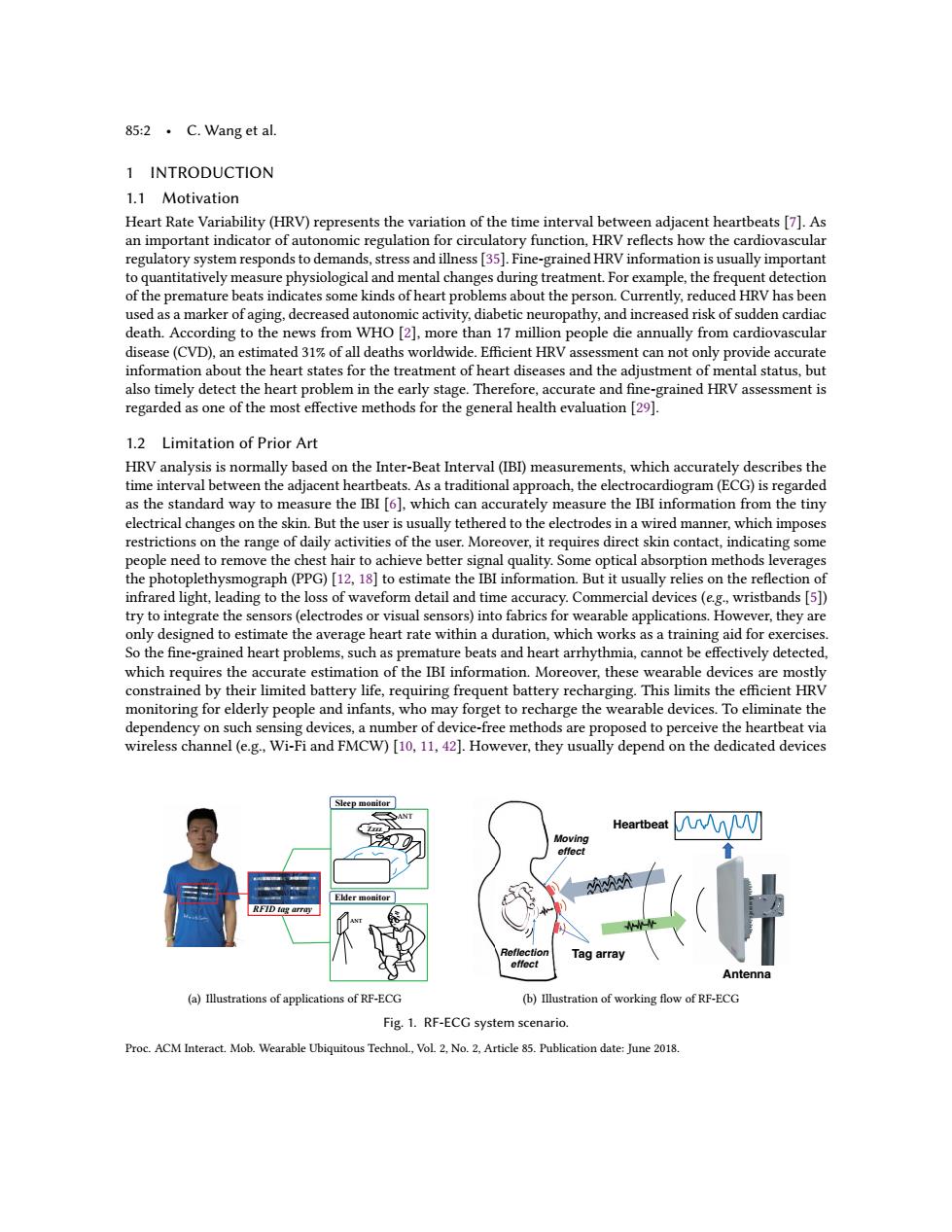正在加载图片...

85:2·C.Wang et al. 1 INTRODUCTION 1.1 Motivation Heart Rate Variability(HRV)represents the variation of the time interval between adjacent heartbeats [7].As an important indicator of autonomic regulation for circulatory function,HRV reflects how the cardiovascular regulatory system responds to demands,stress and illness [35].Fine-grained HRV information is usually important to quantitatively measure physiological and mental changes during treatment.For example,the frequent detection of the premature beats indicates some kinds of heart problems about the person.Currently,reduced HRV has been used as a marker of aging,decreased autonomic activity,diabetic neuropathy,and increased risk of sudden cardiac death.According to the news from WHO [2],more than 17 million people die annually from cardiovascular disease(CVD),an estimated 31%of all deaths worldwide.Efficient HRV assessment can not only provide accurate information about the heart states for the treatment of heart diseases and the adjustment of mental status,but also timely detect the heart problem in the early stage.Therefore,accurate and fine-grained HRV assessment is regarded as one of the most effective methods for the general health evaluation [29]. 1.2 Limitation of Prior Art HRV analysis is normally based on the Inter-Beat Interval(IBI)measurements,which accurately describes the time interval between the adjacent heartbeats.As a traditional approach,the electrocardiogram(ECG)is regarded as the standard way to measure the IBI [6],which can accurately measure the IBI information from the tiny electrical changes on the skin.But the user is usually tethered to the electrodes in a wired manner,which imposes restrictions on the range of daily activities of the user.Moreover,it requires direct skin contact,indicating some people need to remove the chest hair to achieve better signal quality.Some optical absorption methods leverages the photoplethysmograph(PPG)[12,18]to estimate the IBI information.But it usually relies on the reflection of infrared light,leading to the loss of waveform detail and time accuracy.Commercial devices(e.g.,wristbands[5]) try to integrate the sensors(electrodes or visual sensors)into fabrics for wearable applications.However,they are only designed to estimate the average heart rate within a duration,which works as a training aid for exercises. So the fine-grained heart problems,such as premature beats and heart arrhythmia,cannot be effectively detected, which requires the accurate estimation of the IBI information.Moreover,these wearable devices are mostly constrained by their limited battery life,requiring frequent battery recharging.This limits the efficient HRV monitoring for elderly people and infants,who may forget to recharge the wearable devices.To eliminate the dependency on such sensing devices,a number of device-free methods are proposed to perceive the heartbeat via wireless channel(e.g.,Wi-Fi and FMCW)[10,11,42].However,they usually depend on the dedicated devices Sleep monitor SANT Heartbeat W Elder monitor RFID tag arr Tag array Antenna (a)Illustrations of applications of RF-ECG (b)Illustration of working flow of RF-ECG Fig.1.RF-ECG system scenario. Proc.ACM Interact.Mob.Wearable Ubiquitous Technol..Vol 2.No.2.Article 85.Publication date:lune 2018.85:2 • C. Wang et al. 1 INTRODUCTION 1.1 Motivation Heart Rate Variability (HRV) represents the variation of the time interval between adjacent heartbeats [7]. As an important indicator of autonomic regulation for circulatory function, HRV reflects how the cardiovascular regulatory system responds to demands, stress and illness [35]. Fine-grained HRV information is usually important to quantitatively measure physiological and mental changes during treatment. For example, the frequent detection of the premature beats indicates some kinds of heart problems about the person. Currently, reduced HRV has been used as a marker of aging, decreased autonomic activity, diabetic neuropathy, and increased risk of sudden cardiac death. According to the news from WHO [2], more than 17 million people die annually from cardiovascular disease (CVD), an estimated 31% of all deaths worldwide. Efficient HRV assessment can not only provide accurate information about the heart states for the treatment of heart diseases and the adjustment of mental status, but also timely detect the heart problem in the early stage. Therefore, accurate and fine-grained HRV assessment is regarded as one of the most effective methods for the general health evaluation [29]. 1.2 Limitation of Prior Art HRV analysis is normally based on the Inter-Beat Interval (IBI) measurements, which accurately describes the time interval between the adjacent heartbeats. As a traditional approach, the electrocardiogram (ECG) is regarded as the standard way to measure the IBI [6], which can accurately measure the IBI information from the tiny electrical changes on the skin. But the user is usually tethered to the electrodes in a wired manner, which imposes restrictions on the range of daily activities of the user. Moreover, it requires direct skin contact, indicating some people need to remove the chest hair to achieve better signal quality. Some optical absorption methods leverages the photoplethysmograph (PPG) [12, 18] to estimate the IBI information. But it usually relies on the reflection of infrared light, leading to the loss of waveform detail and time accuracy. Commercial devices (e.g., wristbands [5]) try to integrate the sensors (electrodes or visual sensors) into fabrics for wearable applications. However, they are only designed to estimate the average heart rate within a duration, which works as a training aid for exercises. So the fine-grained heart problems, such as premature beats and heart arrhythmia, cannot be effectively detected, which requires the accurate estimation of the IBI information. Moreover, these wearable devices are mostly constrained by their limited battery life, requiring frequent battery recharging. This limits the efficient HRV monitoring for elderly people and infants, who may forget to recharge the wearable devices. To eliminate the dependency on such sensing devices, a number of device-free methods are proposed to perceive the heartbeat via wireless channel (e.g., Wi-Fi and FMCW) [10, 11, 42]. However, they usually depend on the dedicated devices RFID tag array Elder monitor Sleep monitor (a) Illustrations of applications of RF-ECG Tag array Antenna Heartbeat Reflection effect Moving effect (b) Illustration of working flow of RF-ECG Fig. 1. RF-ECG system scenario. Proc. ACM Interact. Mob. Wearable Ubiquitous Technol., Vol. 2, No. 2, Article 85. Publication date: June 2018.�������